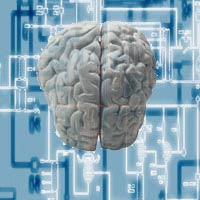Hold on to your hats folks, major brain mapping breakthrough.
Thanks to Betterhumans for bringing my attention to this by posting the article here
My interpretation for the layman:
With this technique you can generate a high resolution (1 micron, a 1000 fold improvement over the best MRI machines) map of an entire brain in a not too significant amount of time (1 day for mice, probably weeks for a human). The technique is destructive, so it is not particularly useful for living brains, but it is extremely useful for trying to understand the physical connectivity of an entire brain. A human brain chemically fixed shortly after death would be able to be used to make a map that would let us understand a great deal of the neural pathways. It will take a while to understand all this connectivity, but because the images are being stored digitially this may be able to be automated in software. This may be a key breakthrough in understanding neural structure.
This is the abstract
Neuron, Vol 39, 27-41, 3 July 2003
Neurotechnique
All-Optical Histology Using Ultrashort Laser Pulses
Philbert S. Tsai 1, Beth Friedman 2, Agustin I. Ifarraguerri 8, Beverly D.
Thompson 9, Varda Lev-Ram 3, Chris B. Schaffer 1, Qing Xiong 4, Roger Y. Tsien
3,4,5,6, Jeffrey A. Squier 10, and David Kleinfeld *1,6,7
As a means to automate the three-dimensional histological analysis of brain
tissue, we demonstrate the use of femtosecond laser pulses to iteratively cut
and image fixed as well as fresh tissue. Cuts are accomplished with 1 to 10 mJ
pulses to ablate tissue with micron precision. We show that the permeability,
immunoreactivity, and optical clarity of the tissue is retained after pulsed
laser cutting. Further, samples from transgenic mice that express fluorescent
proteins retained their fluorescence to within microns of the cut surface.
Imaging of exogenous or endogenous fluorescent labels down to 100 mm or more
below the cut surface is accomplished with 0.1 to 1 nJ pulses and conventional
two-photon laser scanning microscopy. In one example, labeled projection
neurons within the full extent of a neocortical column were visualized with
micron resolution. In a second example, the microvasculature within a block of
neocortex was measured and reconstructed with micron resolution.










































